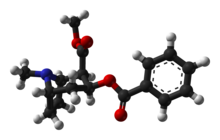Cocaine
 |
|
 |
|
| Clinical data | |
|---|---|
| Trade names | Psicaine, Delcaine, Ensan Cocaine |
| AHFS/Drugs.com | Micromedex Detailed Consumer Information |
| Pregnancy category |
|
| Dependence liability |
Physical: none Psychological: High |
| Addiction liability |
High |
| Routes of administration |
Topical, oral, insufflation, intravenous |
| Drug class |
CNS stimulant Local anesthetic |
| ATC code | N01BC01 (WHO) R02AD03 (WHO), S01HA01 (WHO), S02DA02 (WHO) |
| Legal status | |
| Legal status |
|
| Pharmacokinetic data | |
| Bioavailability |
By mouth: 33% insufflated: 60–80% nasal spray: 25–43% |
| Metabolism | liver CYP3A4 |
| Onset of action | seconds to minutes |
| Biological half-life | 1 hour |
| Duration of action | 5 to 90 minutes |
| Excretion | Kidney |
| Identifiers | |
|
|
| Synonyms | Benzoylmethylecgonine, coke |
| CAS Number |
50-36-2 53-21-4 |
| PubChem (CID) | 446220 |
| IUPHAR/BPS | 2286 |
| DrugBank |
DB00907 |
| ChemSpider |
10194104 |
| UNII |
I5Y540LHVR |
| KEGG |
D00110 |
| ChEBI |
CHEBI:27958 |
| ChEMBL |
CHEMBL370805 |
| PDB ligand ID | COC (PDBe, RCSB PDB) |
| ECHA InfoCard | 100.000.030 |
| Chemical and physical data | |
| Formula | C17H21NO4 |
| Molar mass | 303.353 g/mol |
| 3D model (Jmol) | Interactive image |
| Melting point | 98 °C (208 °F) |
| Boiling point | 187 °C (369 °F) |
| Solubility in water | ~1.8 mg/mL (20 °C) |
|
|
|
|
| See also: data page | |
|
|
|
Cocaine, also known as coke, is a strong stimulant mostly used as a recreational drug. It is commonly snorted, inhaled, or injected into the veins. Mental effects may include loss of contact with reality, an intense feeling of happiness, or agitation. Physical symptoms may include a fast heart rate, sweating, and large pupils. High doses can result in very high blood pressure or body temperature. Effects begin within seconds to minutes of use and last between five and ninety minutes. Cocaine has a small number of accepted medical uses such as numbing and decreasing bleeding during nasal surgery.
Cocaine is addictive due to its effect on the reward pathway in the brain. After a short period of use, there is a high risk that dependence will occur. Its use also increases the risk of stroke, myocardial infarction, lung problems in those who smoke it, blood infections, and sudden cardiac death. Cocaine sold on the street is commonly mixed with local anesthetics, cornstarch, quinine, or sugar which can result in additional toxicity. Following repeated doses a person may have decreased ability to feel pleasure and be very physically tired.
Cocaine acts by inhibiting the reuptake of serotonin, norepinephrine, and dopamine. This results in greater concentrations of these three neurotransmitters in the brain. It can easily cross the blood–brain barrier and may lead to the breakdown of the barrier. Cocaine is made from the leaves of the coca plant which are mostly grown in South America. In 2013, 419 kilograms were produced legally. It is estimated that the illegal market for cocaine is 100 to 500 billion USD each year. With further processing crack cocaine can be produced from cocaine.
...
Wikipedia
